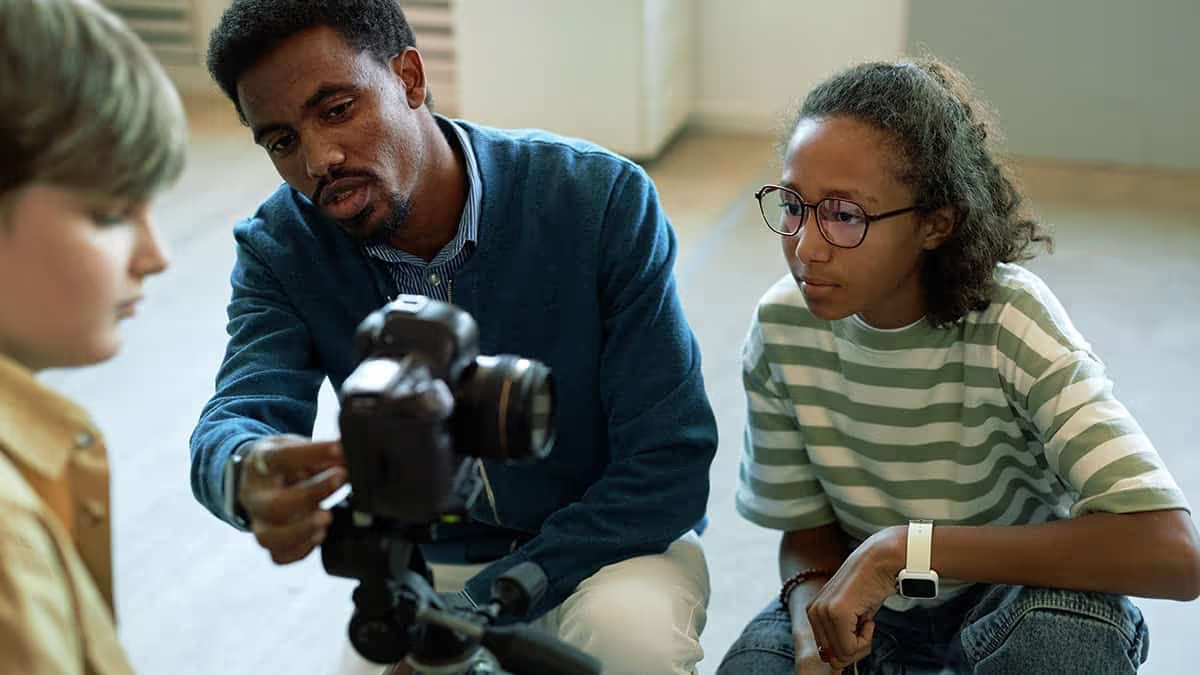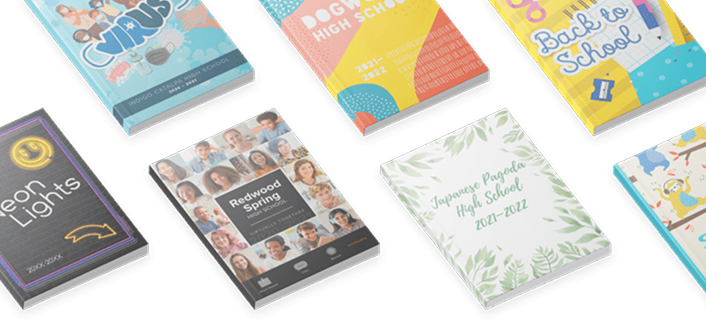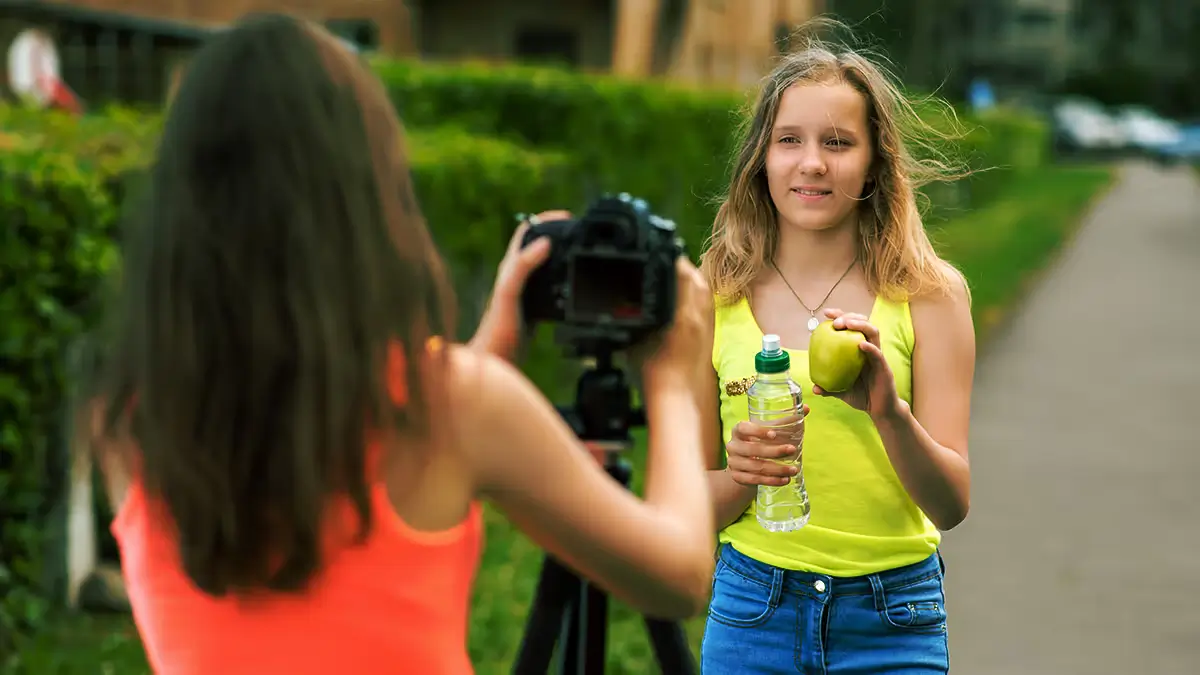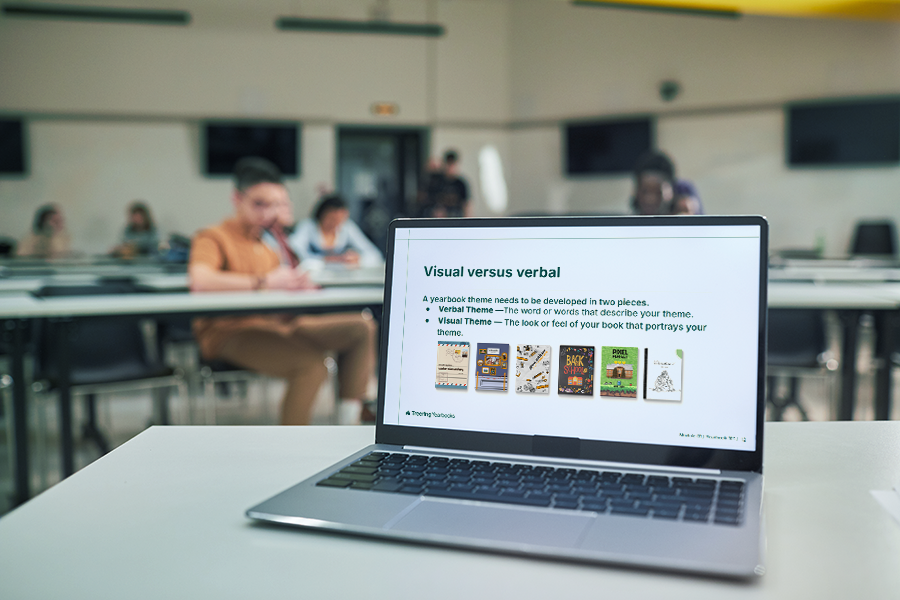Most popular
Subscribe to our blog
Most recent
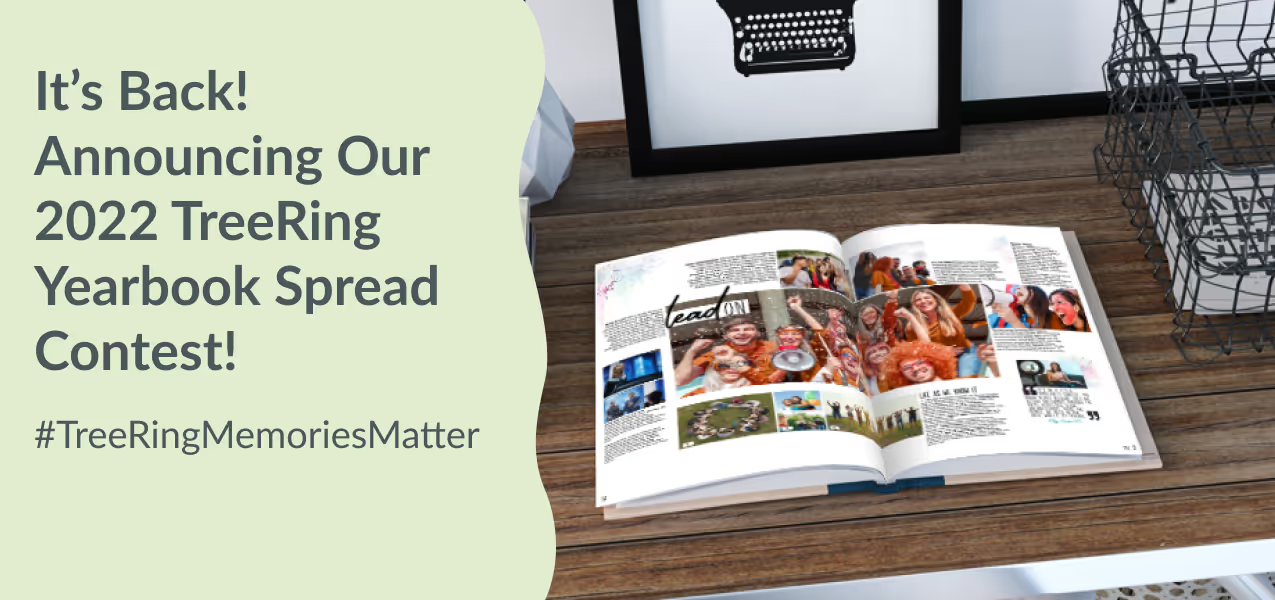
#treeringmemoriesmatter yearbook design contest 2022
Official Contest Participation Rules and Steps to Enter
1. You must be a student, teacher, or parent at a Treering school to participate.
2. To participate, fill out this submission form and include a screenshot of your favorite 21-22 yearbook spread and also a short paragraph (250 words max) about your school’s story. (This part is SUPER important!) Double-check everything for accuracy, especially your email and phone number (this is how winners will be notified and prizes will be distributed) and your school name and address (city and state only are ok). Incomplete entries will not be accepted.
3. Share your spread on social media via:
- Facebook: Submit the post using your personal Facebook account or your school’s Facebook account.
Include the screenshot of your personal page(s) in your post.
Tag @treering in your post.
Use the hashtag #TreeringMemoriesMatter in your post.
Make sure this post is shared publicly so we can see it and include your submission. - Instagram: Submit the post using your personal Instagram account or your school’s Instagram account.
Include the screenshot of your personal pages in your post.
Tag @TreeringCorp in your post.
Use the hashtag #TreeringYearMemoriesMatter in your post.
Make sure your profile is public so we can see it and include it in your submission.
Note: You don’t need to share on both platforms, you can if you want, but you only need to share it on one platform (Facebook or Instagram) to get credit.
4. Submissions are due by Wednesday, March 30, 2022, by 8 PM PT.
Winners

The winners of the #TreeringMemoriesMatter Yearbook Design Contest 2022 will be notified via email and phone on Monday, April 4. The Amazon gift cards will be sent electronically to the email provided in the form. Free books coupons will be loaded into the school's Treering Yearbook account and may be used in the 2021-2022 or 2022-2023 school year.
There will be a first, second, and third-place winner in separate elementary, middle, and high school categories. Yearbook parents may also enter their personal pages to win the #TreeringMemoryMaker parent contest!
Judging will be based on the entered custom page spread and storytelling ability. A panel of yearbook professionals, graphic designers, parents, and journalism educators will select the winners.
Ownership
By submitting your yearbook spread, you have verified the approval of others pictured and you approve Treering to use your name, write-up, and school name for any marketing purposes, including but not limited to showcasing on www.Treering.com, sharing on social media, and sharing with media.
Enjoy yourself! We love this journey for you. If you have any questions, contact us at marketing@treering.com.
Legal Mumbo Jumbo
*No Purchase Necessary. A Purchase Will Not Increase Your Chances Of Winning.*
1. Eligibility: The Contest is open only to legal residents of the United States who are at least eighteen (18) years old. Employees of Treering, LLC (“Sponsor”) or PeakActivity (“Administrator”), as well as the immediate family (spouse, parents, siblings, and children) and household members of those employees, are not eligible to enter.
2. How to Enter
3. Message and data rates may apply to entries posted from a mobile device.
4. By entering, you indicate your full agreement to these Official Rules and Sponsor’s decisions regarding the Giveaway, which are final and binding. Winning a prize is contingent upon fulfilling all requirements in these Official Rules.
5. Potential Winner Requirements: Except where prohibited, a potential winner will be required to complete and return an affidavit of eligibility and a liability/publicity release. If a potential winner fails to sign and return these documents within three (3) business days, Sponsor may select an alternate potential winner in his/her place according to the Judging Criteria.
6. Prizes: first place - 10 free yearbooks, $100 Amazon gift card, and blog profile; second place - five free yearbooks, $50 Amazon gift card; third place - three free yearbooks, $25 Amazon gift card
7. General Conditions: In the event that the operation, security, or administration of the Contest is impaired in any way, Sponsor may, in its sole discretion, either: (a) suspend the Contest to address the impairment and then resume the Contest in a manner that best conforms to the spirit of these Official Rules; or (b) award the prizes based on the Judging Criteria from among the eligible entries received up to the time of the impairment. Sponsor reserves the right, in its sole discretion, to disqualify any individual who tampers with the operation of the Contest, violates these Official Rules, or acts in an unsportsmanlike or disruptive manner. Sponsor reserves the right to seek damages from any person who seeks to undermine the legitimate operation of the Contest. Failure by Sponsor to enforce any term of these Official Rules shall not constitute a waiver of that provision. Proof of sending any communication to Sponsor by mail shall not be deemed proof of receipt of that communication by Sponsor. The Contest is subject to federal, state, and local laws and regulations and is void where prohibited.
8. Release and Limitations of Liability: By entering, you agree to release and hold harmless Sponsor, PeakActivity, Facebook, Instagram, their respective parents, subsidiaries, affiliates, and each of their respective officers, directors, employees, and agents (the “Released Parties”) from and against any claim or cause of action arising out of participation in the Contest or receipt or use of any prize, including, but not limited to: (a) unauthorized human intervention in the Contest; (b) technical errors related to computers, servers, providers, or telephone or network lines; (c) printing errors; (d) lost, late, postage-due, misdirected, or undeliverable mail; (e) errors in the administration of the Contest or the processing of entries; or (g) injury or damage to persons or property. You further agree that in any cause of action, in no event shall the Released Parties be liable for attorney’s fees. You waive the right to claim any damages whatsoever, including, but not limited to, punitive, consequential, direct, or indirect damages.
9. Privacy and Publicity: Any information you submit as part of the Contest will be treated in accordance with Sponsor’s Privacy Policy. Except where prohibited participation in the Contest constitutes an entrant’s consent to Sponsor’s use of his/her name, likeness, voice, opinions, biographical information, and state of residence for promotional purposes in any media without further payment or consideration.
10. Disputes: You agree that any and all disputes, claims, and causes of action arising out of, or connected with, the Contest or any prize awarded shall be resolved individually, without resort to any form of class action, and exclusively by the appropriate court located in Palm Beach County, Florida. All issues and questions concerning the construction, validity, interpretation and enforceability of these Official Rules, your rights and obligations, or the rights and obligations of the Sponsor in connection with the Contest, shall be governed by, and construed in accordance with, the laws of Florida, without giving effect to any choice of law or conflict of law rules (whether of Florida or any other jurisdiction), which would cause the application of the laws of any jurisdiction other than Florida.
11. Winner Information: Winners will be notified via email and phone after the Contest ends.
12. Sponsor and Administrator: The Contest is sponsored by Treering. The Contest is not sponsored, endorsed, or administered by, or associated with, Facebook and Instagram.

What should I do with all my child's art?
Dear Mama, you're not alone. Many of us look at the creations in our children’s portfolio and think, “Now what?” The fridge is covered. The more ambitious among us swap out art in frames, while others load up bin after bin (or just chuck it in the bin). We have an art display idea to help you preserve your child's memories.
How to Photograph Your Child’s Art
The number one rule in photography applies here: get your lighting right! Eliminate shadows and flares by having multiple points of lighting. Natural lighting by a window is best.

Second, you’re going to want to make sure your camera angle is congruent to your art. (See, that high school geometry class has real world application!) This gets rid of distortion. You can make slight adjustments using your camera app.
Personalized Pages
Now that your child’s art is digitized, do something with it!
Since every Treering yearbook comes with two, free personalized pages that print only in your yearbook, you can create a mini-gallery to display paintings, sculptures, and sketches without giving away more real estate in your home. (You can also add more pages for homework, family vacations, and events.)
Fast forward to high school graduation: all your yearbooks are lined up and you can show off your child's progression in penmanship, Scouting, or science fair.
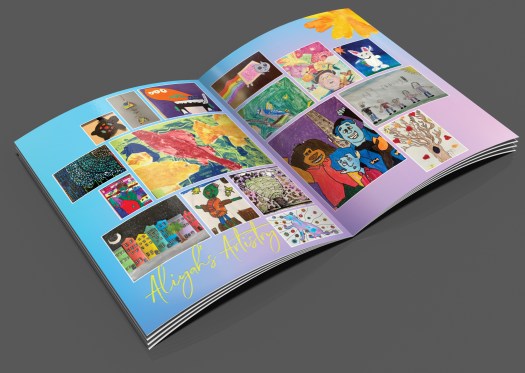
Instead of suffering from mom guilt, you can display your child's year in art forever.

7 yearbook traditions we love
Building a yearbook program relies on building traditions with your staff and school community. When we build school traditions, we create a culture and expectations while transmitting values. That doesn’t equate with inflexibility, rather it provides a guide within which we ebb and flow. While the greatest tradition is the yearbook itself (more on that in a second), here are six others to build a lasting program.
An American institution since George K. Warren took photos of graduates in the late 19th century and sold them as prints to share, yearbooks are the definitive school tradition. What started off as a college-only record book now extends to elementary schools.
This adviser has watched students from world history classes grab yearbooks from the idea library and scour copies from other schools while awaiting the bell to ring. With no connection to the students, these school desk critics compared how our programs—such as ASB, athletics, and the arts—matched up with theirs. They evaluated the theme, mainly the visual components, and gave me a three-minute critique. [Pats self on back for not laughing.]
1. Staff Traditions
Yearbook Wedding
Trending with middle and high school staffs, yearbooks weddings are a pre-production celebration where students pledge themselves to the task.
- The yearbook staff writes vows. This can be as simple as providing a positive atmosphere and completing assignments on time, or as specific as SMART goals for coverage and sales.
- The adviser invites parents and stakeholders (admin, student leadsherhip, coaches, parent org leaders) to attend
- At the ceremony, students recite their vows and receive a ring
- Everyone eats cake
#Yerdsgiving
First of all, yerd means yearbook nerd and it’s polarizing: people loathe or love it. (For those of you playing along at home, I'm the former.) Regardless, #yerdsgiving is the annual gathering of journalism students over food before Thanksgiving break. Some students lead crafts or games, some practice the art of gluttony. Most take the time to craft thank you cards to school staff and students as well as vendors and parents who helped the yearbook team gain momentum at the start of the year. This yearbook tradition is also an avenue to invite alumni to inspire your current staff or even families to celebrate.

Holiday gift exchange
While it seems like you have a gift exchange for every group with which you’re involved, keep it simple:
- Hold a re-gift exchange where students bring in something they received and don’t want.
- Exchange variations on a theme such as socks or snacks
- Put dollar store stockings up with 3x5 cards so classmates can write notes of encouragement
Yearbook Banquet
Being on yearbook staff has to have perks, and one is a fancy-pants dinner before distribution. (Please note fancy is a relative term: we’ve done everything from a chain Italian restaurant to a steakhouse to a revolving sushi bar.) Think of your typical sports banquet: the coach (adviser) stands and speaks a few remarks on the team then hands out the awards. Traditionally, the yearbook staff unwraps their yearbook and shares it with their family. It’s special because they have the first copies and it’s individualized time for parents to see all the work their child accomplished.
2. Thematic Marketing
Theme surveys are a fun way to raise awareness that yearbook sales began as well as get buy-in from your school on the theme. While yearbook purists believe a theme should apply to one year only, you may find several coveted visual aesthetics from Treering Yearbooks’ theme gallery.
The big reveal can happen once you receive your printed proof and you can make videos and social media teasers with your staff. Some schools make it one of their back to school traditions to reveal the yearbook theme at the start of the school year and use it throughout to market the book and generate content by
- Making T-shirts and wearing them when they are photographing events (remember that QR code to buy!)
- Creating thank you cards, Google slide presentations, and posters via theme graphics
- Asking related questions via social media; for example, with a theme “Give + Take,” ask for multiple takes on the fun run or invite athletes give their top five songs for warm up
- Keeping everything yearbook-related in your theme colors
3. 3x Yearbook Coverage
Maximizing coverage should be a tradition for every yearbook staff. If we are truly telling the story of the year, it involves everyone on campus. From a yearbook marketing perspective, if students know they are in the book, they will want the book. If they want the book, parents will buy the book.
We love thinking of yearbooks as memory books—they are—they are also a component of the historical record.
4. Staff Recruitment and Announcement
Your yearbook team is a big deal. Say it with me, "We are a big deal!" Create yearbook staff traditions around recruitment and the announcement of who made the cut each spring. Some ideas include
- Host a party and pass out applications
- Crown your staff publicly (feather boas, sashes, and capes work well too)
- Publicize who is on your yearbook team in newsletters, on social media, and in the front office so parents, coaches, and prospective volunteers can get in touch with you
After all, your yearbook team is a big deal.
5. Freeze time
You don’t have to be Doc and Marty McFly to time travel. Year after year, yearbooks create a personal history; the yearbook might be a few hours of reading during summer, and when you fast forward five or ten years, it will be so much more. Moms, let’s face it, our yearbooks give our kids license to laugh at our hair, clothes, and priorities.
The value of a yearbook does not end at graduation.

6. Dedication
Does your school have a tradition of dedicating the yearbook to a member of your staff or community? If not, skip to the next section. This gets political.
A yearbook dedication could
- Thank a teacher for being a yearbook champion
- Recognize an administrator who is retiring
- Honor a member of the faculty who impacted the school community
- Be a blanket statement to a group on campus, such as the robotics team who went to the national championship for the first time
- Congratulate the promoting/graduating class
7. Yearbook Distribution Party Traditions
Many schools have a special, extended lunch or tie distribution to an all-school event to celebrate the end of the year. A word of advice: if this is a new tradition for you, connect with school leadership early to plan your distribution day.
The good
A simple party with pens, tunes, and tables is all you need. Always invite non-buyers to include them in the signing. More than likely, they'll be the first to buy a book next year. (And if you're using Treering Yearbooks to publish, parents can still buy a book!)
Pizza, a DJ, and pens that correspond to class colors take it to the next level.
The extra
One K-12 school I know used to have students line up outside a bounce house. After they climbed up and slid down, they'd receive their yearbook.
Another elementary school invites the middle school cheerleaders to the signing party. They perform and pump up the 5th graders for fall.
Whichever yearbook traditions you employ, make sure they match your community. If you're just getting started, select one and own it. Once it's routine, add another.
QR Code is a registered trademark of DENSO WAVE INCORPORATED.
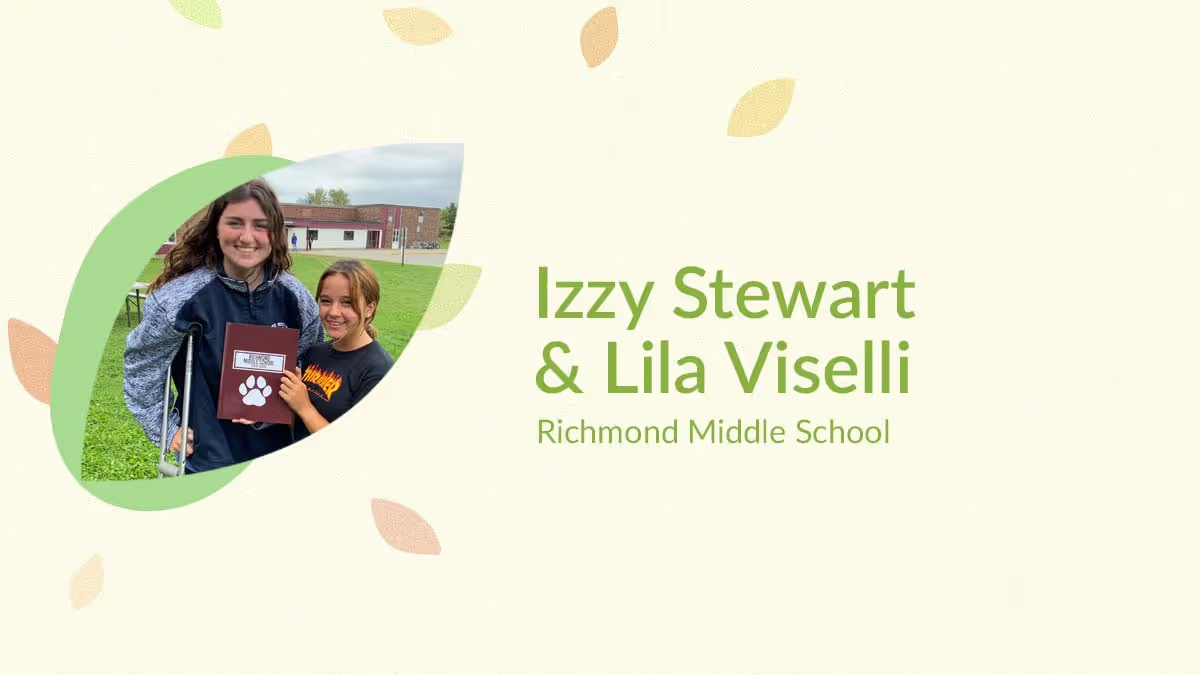
Yearbook heroes Izzy and Lila resurrect a yearbook program
Treering Yearbook Heroes is a monthly feature focusing on yearbook adviser tips and tricks.
This year we at Treering called on all our schools’ parents, teachers, and students to nominate yearbook heroes in a first-ever peoples’ contest: #YearbookHero. The yearbook callout contest was prompted by our empathy and true appreciation for our yearbook editors.
Students Izzy Stewart and Lila Viselli from Richmond Middle School, located in Richmond, Maine won first place in the middle school division of our nationwide contest; they were nominated by their adviser Becca Redman for their work in restarting the yearbook after a six-year hiatus—even when the pandemic hit and the girls had to work on the yearbook from home!
What does it mean to you to be Richmond Middle School’s Yearbook Heroes?
We all think it’s important to get recognized for the work you’ve done when the opportunity presents itself! And in this case, it was Treering’s #YearbookHero Contest. It was quite the surprise to get awarded for the yearbook, and it feels great to be recognized for all of the work that was put into it.
What was it like to bring the yearbook back after six years?
We were thrilled to bring the yearbook back and learned so much as a team - about design, collaboration, communication and time-management. It was a really rewarding experience that hopefully will help students in their other activities and classes. I think it would have been exciting under any circumstance, but we all felt even more satisfied with our work because we put it together during a pandemic, when we were all at home. We had to be creative. I think last year's book reflected lessons we learned the first year, and we see the book getting better with every edition.
How did you gather photos when you were at home? How did you involve and motivate your classmates to contribute to the yearbook?
Ms. Redman: I sent a LOT of emails and contacted parents on Facebook to ask permission to use their photos of school activities in the fall, and to contribute to the quarantine collage. At one point I also gathered the entire team of middle school teachers in a Zoom meeting and took a screenshot of all our smiling faces. It was captioned with a "We Miss You" message. I think that was special for the students, and will definitely be a memento from an unprecedented year.
Izzy and Lila: When we were at home, we’d email a lot of people consistently, including classmates and coaches, in order to motivate them to send us pictures. We also contacted parents to see if they could send us pictures that they’d taken of students and events.
Ms. Redman, how is Richmond Middle School’s Yearbook Club going?
This year, things are going really well! We are still in the planning stages, but definitely learning from the past. For example, after taking photos during Spirit Week and Halloween, we created those pages immediately at the following meeting. I’m sure this will pay off in the spring. One of our past mistakes was definitely leaving a lot of the actual book editing until the end. I'm glad to have a lot of 6th graders expressing interest in the club this year and hopefully they will stay with the club through middle school and be leaders in the future.
I am also lucky to have some really proactive team members who take initiative to take photos during important events—I don't need to remind them! Since Izzy and Lila have graduated from 8th grade, they are definitely missed this year! With that said, I have plans to bring them on board to come and help me teach the current middle schoolers a few key Treering skills. We’ll be working on portraits soon, so that’s definitely something we’ll be focusing on with Treering in the near future.
Izzy and Lila, now that you’re in high school, what advice would you give younger students who are involved in the yearbook?
Never give up and push through obstacles the best that you can. It’s always ok to ask questions and get help! For us, it was very rewarding in the end to bring back the yearbook by using Treering and for everyone to give us positive feedback. It feels good to leave middle school knowing that we brought the yearbook back and left them with a solid foundation to build off of this year and for years to come.

#treeringmemorymaker parent contest 2022
Official Parent Contest Participation Rules and Steps to Enter
1. You must be over 18 years old and a parent at a Treering school to participate.
2. To participate, fill out this submission form and include a screenshot(s) of your custom pages spread and also a short paragraph (250 words max) about your child’s unique story. (This part is SUPER important!) Double-check everything for accuracy, especially your email and phone number (this is how winners will be notified and prizes will be distributed) and your school name and address (city and state only are ok). Incomplete entries will not be accepted.
3. Share your spread on social media via:
- Facebook: Submit the post using your personal Facebook account or your school’s Facebook account.
Include the screenshot of your custom page(s) in your post.
Tag @treering in your post.
Use the hashtag #TreeringMemoryMaker in your post.
Make sure this post is shared publicly so we can see it and include your submission. - Instagram: Submit the post using your personal Instagram account or your school’s Instagram account.
Include the screenshot of your custom pages in your post.
Tag @TreeringCorp in your post.
Use the hashtag #TreeringYearMemoryMaker in your post.
Make sure your profile is public so we can see it and include it in your submission.
Note: You don’t need to share on both platforms, you can if you want, but you only need to share it on one platform (Facebook or Instagram) to get credit.
4. Submissions are due by Wednesday, March 30, 2022, by 8 PM PT.
Winners

The winners of the #TreeringMemoryMaker Parent Contest 2022 will be notified via email and phone on Monday, April 4. The Amazon and spa gift cards will be sent electronically to the email provided in the form. Parents who also serve on the Yearbook Committee can also enter the #TreeringYearbookMemoriesMatter Contest!
Judging will be based on the entered custom page spread and storytelling ability. A panel of yearbook professionals, graphic designers, parents, and journalism educators will select the winners.
Ownership
By submitting your custom pages/spread, you have verified the approval of others pictured and you approve Treering to use your name and school name for any marketing purposes, including but not limited to showcasing on www.Treering.com, sharing on social media, and sharing with media.
Enjoy yourself! We love this journey for you. If you have any questions, contact us at marketing@treering.com.
Legal Mumbo Jumbo
*No Purchase Necessary. A Purchase Will Not Increase Your Chances Of Winning.*
1. Eligibility: The Contest is open only to legal residents of the United States who are at least eighteen (18) years old. Employees of Treering, LLC (“Sponsor”) or PeakActivity (“Administrator”), as well as the immediate family (spouse, parents, siblings, and children) and household members of those employees, are not eligible to enter.
2. How to Enter
3. Message and data rates may apply to entries posted from a mobile device.
4. By entering, you indicate your full agreement to these Official Rules and Sponsor’s decisions regarding the Giveaway, which are final and binding. Winning a prize is contingent upon fulfilling all requirements in these Official Rules.
5. Potential Winner Requirements: Except where prohibited, a potential winner will be required to complete and return an affidavit of eligibility and a liability/publicity release. If a potential winner fails to sign and return these documents within three (3) business days, Sponsor may select an alternate potential winner in his/her place according to the Judging Criteria.
6. Prizes: first place - $300 spa card, $200 Amazon gift card, and blog profile; second place - $200 Amazon gift card; third place - $100 Amazon gift card
7. General Conditions: In the event that the operation, security, or administration of the Contest is impaired in any way, Sponsor may, in its sole discretion, either: (a) suspend the Contest to address the impairment and then resume the Contest in a manner that best conforms to the spirit of these Official Rules; or (b) award the prizes based on the Judging Criteria from among the eligible entries received up to the time of the impairment. Sponsor reserves the right, in its sole discretion, to disqualify any individual who tampers with the operation of the Contest, violates these Official Rules, or acts in an unsportsmanlike or disruptive manner. Sponsor reserves the right to seek damages from any person who seeks to undermine the legitimate operation of the Contest. Failure by Sponsor to enforce any term of these Official Rules shall not constitute a waiver of that provision. Proof of sending any communication to Sponsor by mail shall not be deemed proof of receipt of that communication by Sponsor. The Contest is subject to federal, state, and local laws and regulations and is void where prohibited.
8. Release and Limitations of Liability: By entering, you agree to release and hold harmless Sponsor, PeakActivity, Facebook, Instagram, their respective parents, subsidiaries, affiliates, and each of their respective officers, directors, employees, and agents (the “Released Parties”) from and against any claim or cause of action arising out of participation in the Contest or receipt or use of any prize, including, but not limited to: (a) unauthorized human intervention in the Contest; (b) technical errors related to computers, servers, providers, or telephone or network lines; (c) printing errors; (d) lost, late, postage-due, misdirected, or undeliverable mail; (e) errors in the administration of the Contest or the processing of entries; or (g) injury or damage to persons or property. You further agree that in any cause of action, in no event shall the Released Parties be liable for attorney’s fees. You waive the right to claim any damages whatsoever, including, but not limited to, punitive, consequential, direct, or indirect damages.
9. Privacy and Publicity: Any information you submit as part of the Contest will be treated in accordance with Sponsor’s Privacy Policy. Except where prohibited participation in the Contest constitutes an entrant’s consent to Sponsor’s use of his/her name, likeness, voice, opinions, biographical information, and state of residence for promotional purposes in any media without further payment or consideration.
10. Disputes: You agree that any and all disputes, claims, and causes of action arising out of, or connected with, the Contest or any prize awarded shall be resolved individually, without resort to any form of class action, and exclusively by the appropriate court located in Palm Beach County, Florida. All issues and questions concerning the construction, validity, interpretation and enforceability of these Official Rules, your rights and obligations, or the rights and obligations of the Sponsor in connection with the Contest, shall be governed by, and construed in accordance with, the laws of Florida, without giving effect to any choice of law or conflict of law rules (whether of Florida or any other jurisdiction), which would cause the application of the laws of any jurisdiction other than Florida.
11. Winner Information: Winners will be notified via email and phone after the Contest ends.
12. Sponsor and Administrator: The Contest is sponsored by Treering. The Contest is not sponsored, endorsed, or administered by, or associated with, Facebook and Instagram.

Participate in national scholastic journalism week 2022
Celebrating the students on campus—all of them—is what we love most about inclusive yearbooks. This year, the theme for Scholastic Journalism Week is “Amplifying Voices.” If you’re participating, or here for inspiration, here are some ways to integrate Scholastic Journalism Week into your school and get more students heard.
Monday: Participate in #MakingConnections
From PTA/PTO councils to journalism teachers, there are people willing to share best practices. It’s one of the reasons we love to share about Yearbook Heroes. Identify:
- Who is doing what I want to do?
- What can I learn from them?
- Who can inspire my students?
- What similar stories do we have on campus?
- Who is disconnected? How do we amplify their voice?
You may be the one to teach others—share your story!
Tuesday: #teachmeTuesday
Because this is a celebration of scholastic journalism, take some time to teach journalism. Start with a writing lesson or practice interviewing. Collectively, you could tackle intorduce media literacy or a difficult reporting assignment such as covering the recent wildfires or tornadoes.
Wednesday: be about the business of #SharingStories
Take advantage of our pre-planned social media calendar to jumpstart your shares. Make sure your posts feature diverse grades, activities, and subjects. This way, you show students the value individuals make to the whole of your school community.
In your yearbook, you may want to include quote packages or fill-ins to amplify voices and give students the means to share their stories.
Thursday: always fit in a #throwback
Throwback Thursdays are fun because you can do nearly anything:
- Feature stories from alumni (don’t forget to use their yearbook photo!)
- Collaborate with a social science teacher on campus to integrate journalism's impact on history
- Print and display favorite yearbook spreads or covers from the previous years
Friday: #DemocracyInAction
JEA encourages schools to use the last day of Scholastic Journalism Week to share how their schools and communities value the freedom of the press. Here are some ideas on how to participate:
Elementary Schools
- Memorize the First Amendment
- Start student-led media projects
Middle and High Schools
- Have a conversation with school administration over the Principal’s Guide for Scholastic Journalism
- Learn to evaluate sources
- Memorize the First Amendment
Your participation in Scholastic Journalism Week 2022, be it one day or all five, will show your journalism students their voices matter as well as the responsibility they have as campus advocates to be the voice of others.

3 (but really 7) design elements to up your yearbook's visual appeal
Personal anecdote: In 1996, I joined my first yearbook staff. Shout out to Mr. Wayne Weightman who took a chance on a loud introvert and turned her into a creator. Fast forward a quarter-century (sheesh) and his yearbook design lessons are still impacting students—some of whom are now educators—and scores of creators.
The Easiest Element: Spacing
One pica was the standard back in the day when orange wax pencils and cropping squares were the norms. Each spread was designed on grid paper measured in picas. Below is an example of one pica standard yearbook spacing. It's clean. It's traditional. It's fine.
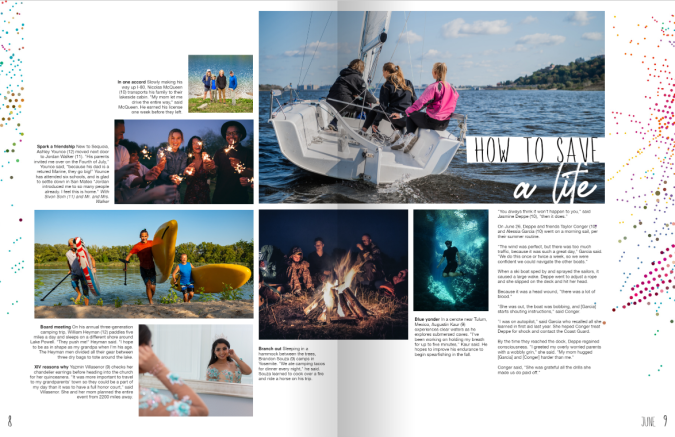
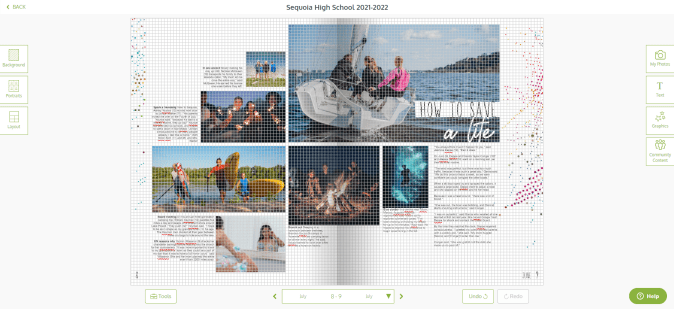
Contrast that with tight spacing. This is one-half pica (the design equivalent of red stilettos). Your spread just had a glow up.
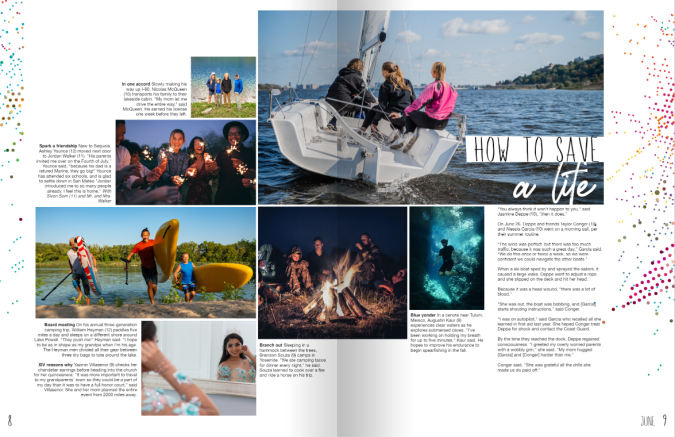
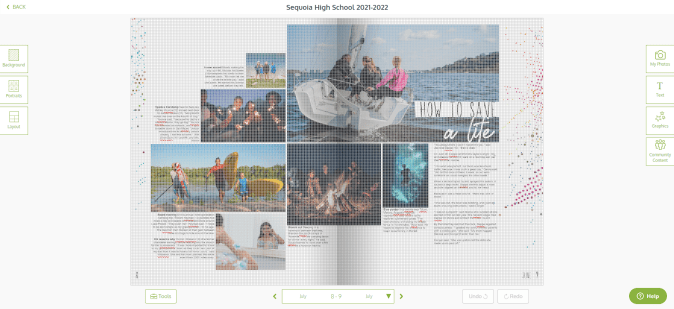
The Dominant Element: Hierarchy in Yearbook Design
Hierarchy tells our buyers what’s important, and for all you ELA teachers, it’s the outline of the spread. Spoiler alert: size matters.
The yearbook design lesson here is to immediately attract your reader’s attention with a dominant image or module. Use the golden spiral to build off your dominant. Use this ready-made yearbook design lesson to help launch your discussion with your students.
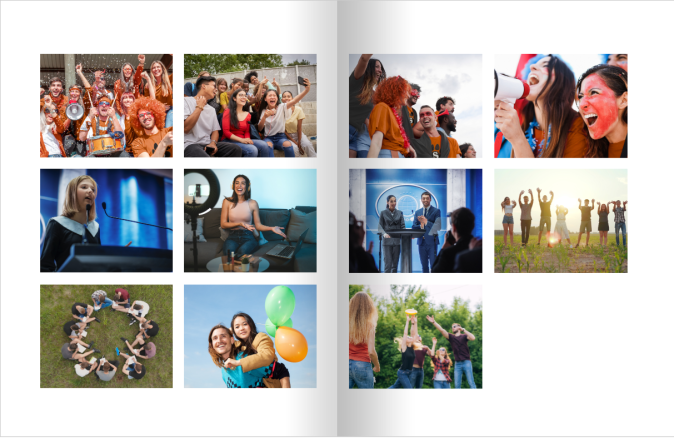

1. Photographs
The most interesting, story-telling, awe-inspiring photo should be dominant on your spread. Connect your headline to this image. You can build off your dominant photograph to fill your spread.
2. Headline
Advertising genius David Ogilvy said, “On the average, five times as many people read the headline as read the body copy. When you have written your headline, you have spent eighty cents out of your dollar.”
Since a headline is our entry point, it should connect yearbook buyers with the focus of the spread. Avoid “Football” when every photo pictures football–your buyers are smarter than that. If you must spell it out, use the folio. Appropriate puns, alliteration, and rhymes are literary techniques to use.
3. Body copy
My yearbook students once tried to 86 captions because “no one reads them.” Another Mr. Weightman yearbook lesson: “If they were worth reading, people would.” Ouch. (And true.)
Lessons centered around the art of open-ended questions made interviewing more of a conversation. Students would develop 10 questions and always end the interview with “Is there anything else I could have asked?”
Oh, and in case you’re wondering, people did read those captions.
If you’re just getting started, practice using anecdotal quotes to fill in captions and add detail. Captions should include facts and sensory details while identifying the subject of the photograph and their grade. More writing lessons abound in the Treering Yearbooks’ free curriculum.
The Fun Elements: the Acronym You and Your Students will Never Forget
Shout out to another design influencer: Robin Williams (not the genie). She’s a proponent of contrast, repetition, alignment, and proximity—master these four things, and everything you touch will be design gold. (I’ll give you one second more to figure out the acronym.) Teach these design elements individually, then combine them for the ultimate yearbook design lesson.
Contrast
Pair a bold font with a condensed one. Use opposite sides of the color wheel. Get crazy with font size (within reason). These design elements teach your reader where to look, and when used in concert with hierarchy, tell your students’ stories in an easy-to-follow manner.
Other ways to create contrast include shape (horizontal vs. vertical) and weight (thick vs. thin).
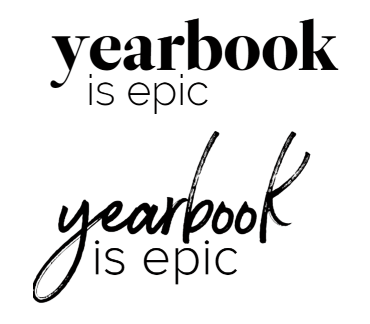
Repetition
From cover to cover, your book should look cohesive. Every layout will not be the same. I repeat, every layout does not have to be the same! Colors, fonts, sizes, and design elements should be consistent throughout your book. Remember, your theme is the brand, and your book is the platform by which you will develop it.
Alignment
Design is intentional. On your yearbook spreads, align
- Copy
- Photographs
- Quote packages
Proximity
Put the things that go together, together. This seems like a no-brainer, and yet, it’s a yearbook design lesson worth refreshing year after year.
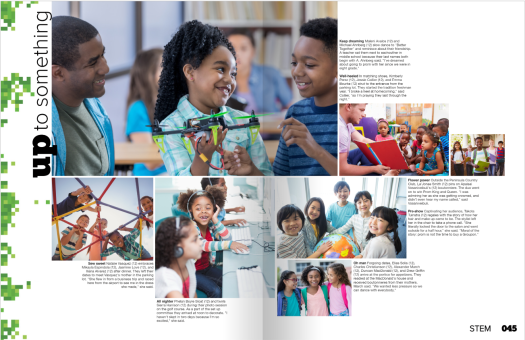
Yearbook design lessons are something you can teach throughout the year. Pin your favorite ideas (or steal some of ours).
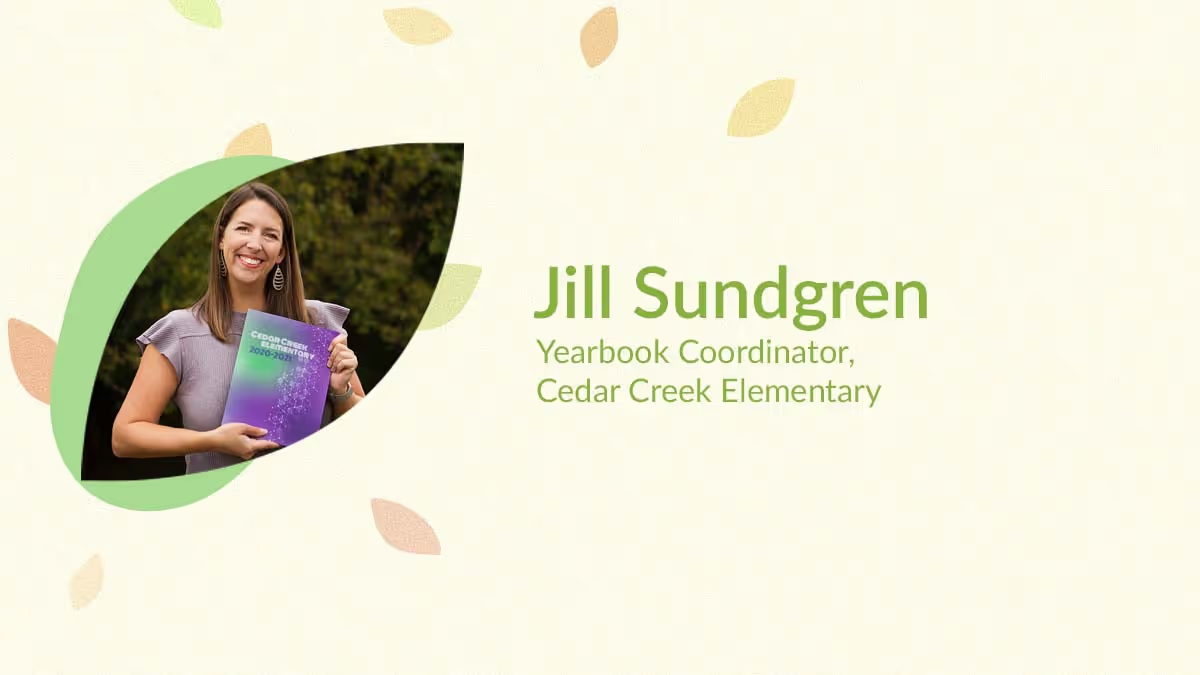
Yearbook hero Jill Sundgren crowdsources a yearbook
Treering Yearbook Heroes is a monthly feature focusing on yearbook adviser tips and tricks.
This year we at Treering called on all our schools’ parents, teachers and students to nominate yearbook heroes in a first-ever peoples’ contest: #YearbookHero. The yearbook callout contest was prompted by our empathy and true appreciation for our yearbook editors.
Jill Sundgren of Cedar Creek Elementary School, located in Olathe, Kansas won first place in the elementary division for the nationwide contest; she was nominated by parent and PTO president, Barb Hendricks, for spearheading the school’s yearbook and inspiring a yearbook committee to work collectively and creatively to capture and preserve the important stories of the year—even when parents weren’t allowed to be on campus!
What does it mean to you to be Cedar Creek Elementary's Yearbook Hero?
I am so honored (and a little shocked) to be named Cedar Creek's Yearbook Hero. But I do feel like this honor really should be extended to my entire committee. This yearbook was definitely a team effort from the design to the brainstorming of pages to layouts to photo gathering. It's so sweet that I am being recognized, but as I'm sure you all know, a yearbook is a huge undertaking and I don't do it alone! I think it's amazing that Cedar Creek is getting recognized for our efforts and creativity because we really do have such an awesome community of parents who make this all possible.
I especially want to thank Barb Hendricks for nominating me and getting me involved in the yearbook in the first place. I absolutely love being involved in the yearbook committee and can't wait to see what this year has in store for us. I think we learned a lot creating the yearbook last year and we are going to try and incorporate some of the ideas that came out of it into future books. I'm hoping to keep up the momentum and produce an even better product this year!
How have you been getting photos when parents aren’t permitted on campus?
Being unable to set foot on campus last year was certainly an obstacle, but with the help of our amazing PTO members, school staff, yearbook committee and community of parents, we were able to still capture the year in a holistic way.
First, we had to get creative on the types of pages we wanted to showcase. A lot of the programs and activities that we normally feature weren't happening last year, so we had to look at some things that happened outside of the school walls to fill the yearbook. We featured seasonal pages (summer, fall, winter and spring activities), sports teams and remote learning, among other activities. Our PTO has a private Facebook page where we solicited photos for some of these activities from parents - and our parents sure did deliver!
Our school still tried to make the year fun by continuing spirit weeks, outdoor photo ops and off-campus activities (for instance, our father/daughter activity was an in-home movie night); so again, we asked parents to snap photos prior to school of their kids dressed up and share with our team. Our principal also let us take photos (outside and masked) as kids arrived at school so we could fill in some holes for our dress-up spirit days. And, of course, we enlisted the help of the teachers to try and capture some photos inside the classroom as well. This all resulted in showcasing our year in and outside of school.
Our ultimate goal was to show that while the pandemic may have changed our way of living, it didn't damper our spirits or ability to have some fun!
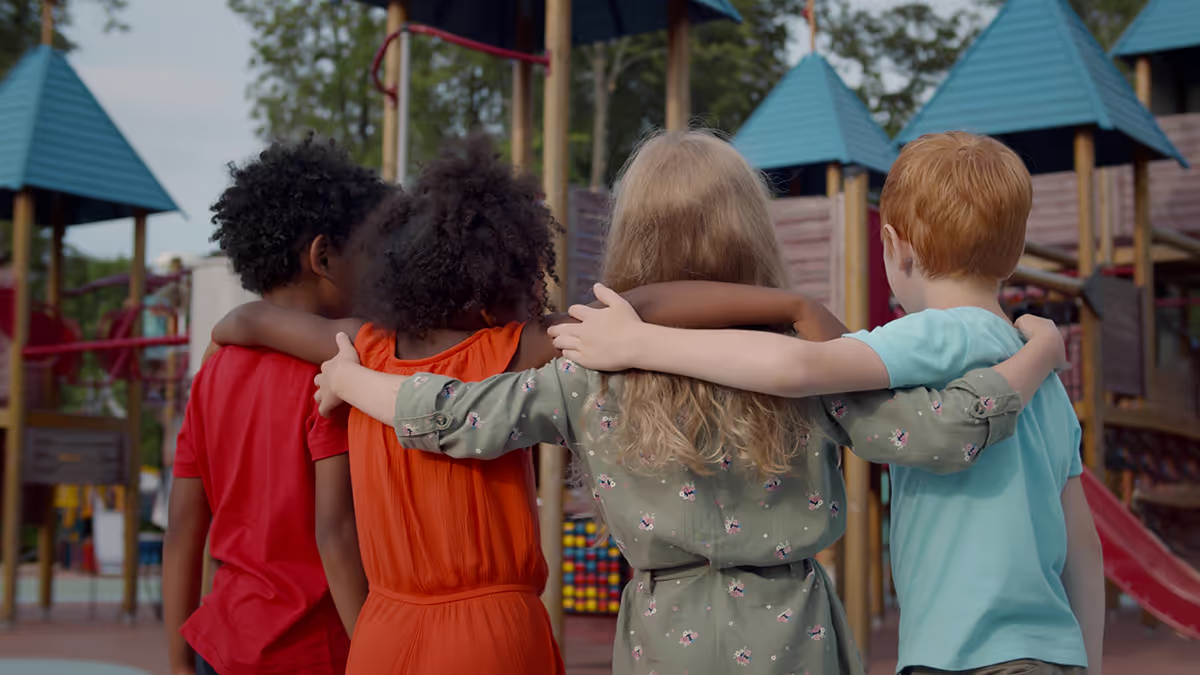
Covering natural disasters in your yearbook
As sad as it is, a lot of communities experience natural disasters, and their people must come together and rebuild. Sometimes it can be a struggle as a yearbook adviser, student editor, or team to decide whether or not to capture this historic event in your school’s yearbook, especially if you have younger students who may not fully grasp what happened. To help alleviate some of the back and forth and uncertainties, we’ve laid out a guide of best practices when covering natural disasters in your yearbook.
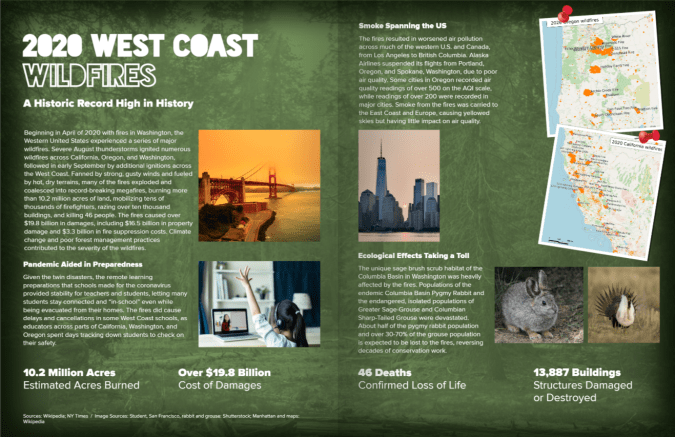
Are Natural Disasters Yearbook-Worthy?
Including current events is typically a staple for every school’s yearbook, since it is essentially a snapshot of what life was like that year. However, determining the best way to cover natural disasters, which are also considered events, isn’t always the first thing that comes to mind for yearbook editors. Or the easiest. And it’s not something for which one can completely prepare. Natural disasters can shape a school year and have an impact on everyone. Because of this, it is worth including it in the yearbook. It’s important to find uplifting ways to cover these stories when interviewing school members while respecting the boundaries of those who were impacted.
The right words and tone can emphasize how a school showcased perseverance in the face of a tragedy.
Include Accurate and Approved Information in your Coverage
Be it wildfires, tornados, hurricanes, or earthquakes, it’s critical to provide accurate information about the event. When looking back at a yearbook years from now, you don’t want the wrong date, for example, to be in print. The goal is for students to be able to look back to remember this part of their history. And ideally, the way it’s covered in the yearbook can show how the school and community overcame the crisis.
Unless you’re lucky enough to have a copyright lawyer on your yearbook committee, it’s critical to understand the basics of trademark and copyright laws when deciding on if/when to use professional photos to cover a natural disaster. You always want to make sure it’s an image you are allowed to use and that it’s free to the public. If this seems like something you don’t have time to research, instead it might be worth considering stock images that are available online, licensing images from your local newspaper, or using—with permission—photos your community has captured.
Along with photos, you should also consider the statistics to highlight. It’s important to remain sensitive and not include mentions of a death toll, for example. Instead, you can focus on other hard facts like the date(s), time, location, the scale of the natural disaster, etc. in your yearbook. If your school community collected donations, include those numbers.
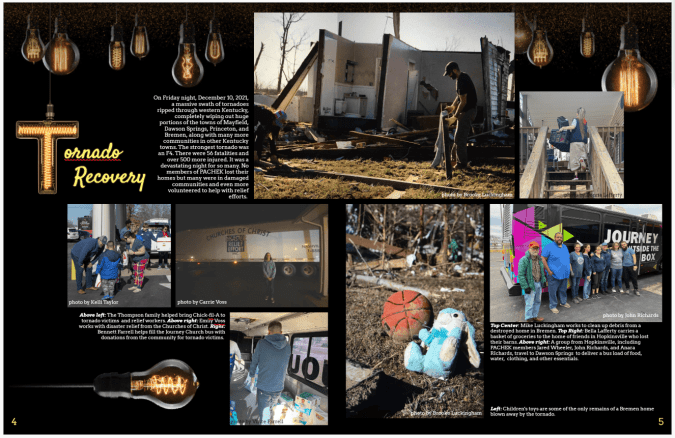
When it comes to deciding on what information to include, a great tip is to make sure that your yearbook committee has an editorial policy in place that can be shared with the community. Covering any kind of crisis can be difficult, and some may always disagree with the way you did it, so it’s best to have a written policy so that teachers, students, and parents can be aware of how the yearbook team will plan to cover a crisis like a natural disaster or a death in your school community. Get your administrator's signature on it.
Lessons Students Can Learn from Natural Disasters
A tragedy is not something anyone can overcome easily. It’s worth highlighting the hope of people within a community when they’re facing hardship together. Experiencing something of this nature becomes a part of one’s story and while it may take some extra dedicated time to determine how to showcase the lessons learned in a positive way, it’ll be beneficial to capture an impactful time such as this in a yearbook.
Interview Questions for Students and Teachers Impacted by Disasters
- How did the [natural disaster] impact the community?
- What was, or is currently, being done to help rebuild?
- Are there any stories you’re comfortable sharing about the [natural disaster’s] personal impact?
- Where were you and what were you doing as this event unfolded?
- How has the [natural disaster] impacted how you view your day-to-day life at home and at school?
- What advice would you give to students who may face a similar natural disaster crisis in the future?
- What are you grateful for after this?
- What changes did you see within the community during and after this event?
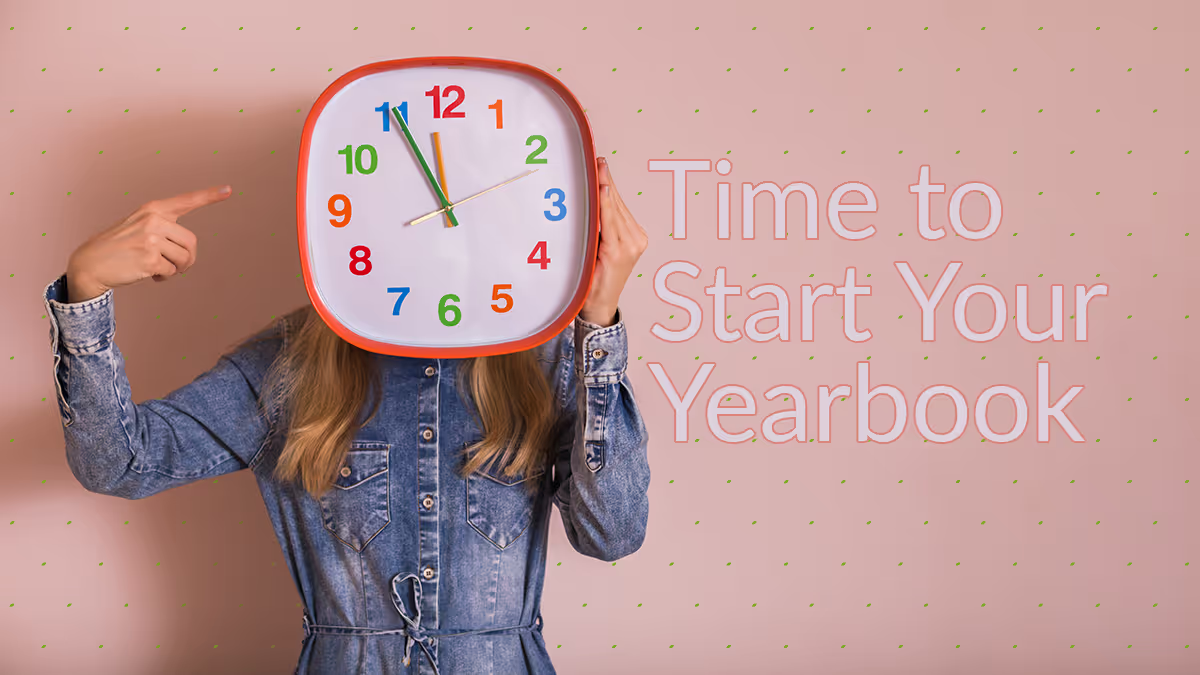
Create a quick, easy, and beautiful elementary school yearbook
With most of the school year in the proverbial book, we are counting down until summer vacation. End-of-the-year celebrations aren't complete without a yearbook. If you're the one wearing the yearbook coordinator crown, it's time to circle the wagons and quickly create your elementary school yearbook without sacrificing style. We have live webinars on Wednesdays to help jumpstart your second semester.

Step 1: Upload Your Student Roster
Your first step is a quick visit to the front office (remember to bring some lattes) to get a community and student roster. This seems tedious. It will save you hours if you do this first. You will easily be able to
- Tag to ensure inclusivity or to create an index
- Start marketing and selling your book
- Receive your yearbooks sorted by your choice of grade, teacher, or last name which will save you tons of time once they arrive
(We promise, you'll thank us later.)
Step 2: Get the Word Out
With an updated student roster, you can now effectively communicate with your community and launch marketing campaigns that support yearbook building and orders. Examples of communication that will help you build a better book include emails asking for photos, how to purchase books, and special features like creating personalized pages and showing your students/parents how to create e-signatures.
If you really want to ramp up sales and raise awareness of your yearbook project and photo needs, use this month of Instagram, Facebook, TikTok, and Twitter content. There's also a full marketing module in our free yearbook curriculum.
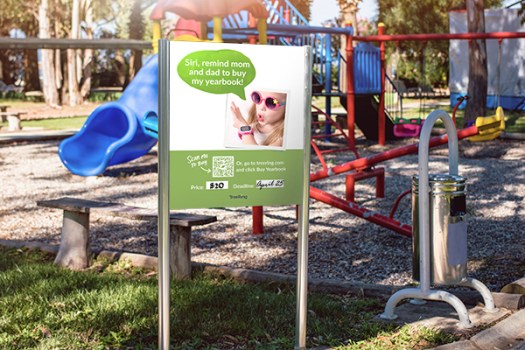
Step 3: Collaborate with your Community
Following strong communication, you are set up to collaborate on the yearbook with ease. Crowdsource photos from school staff, other parents, coaches, and students.
When possible, assign class pages to others. No yearbook coordinator is an island (or something like that). By building a team, you'll capture more, include more, and stress out less!
Step 4: Upload Your Students' Portraits
Whether your elementary school was able to take professional portraits, or you are sourcing portraits from parents, upload these to your yearbook next. Your yearbook provider should have a solution for adding these to your book. You can even use these yearbook spreads to add more content.
Step 5: Build your Book
Now that you’ve connected with your community and begun sourcing ideas and visuals for your yearbook, you’re ready to select and set up your book themes and styles. In addition to designing your own themes, Treering offers a free library of professionally designed themes. Each theme package includes layouts, font pairings, and graphics to tie your look together. You can also 100% customize your own.
Set spreads aside for
- School events such as fun runs and book fairs
- Sports (If your school doesn't have teams, crowdsource photos of students on their outside sports team)
- Holidays
- Trends
- Clubs
- Class favorites
Build a beautiful yearbook with features like auto-page layouts that magically lay your photos out beautifully on a spread or pre-designed pages that cover the Best of the Year and Year in Review plus student-generated content through fill-ins for a quick elementary school layout.
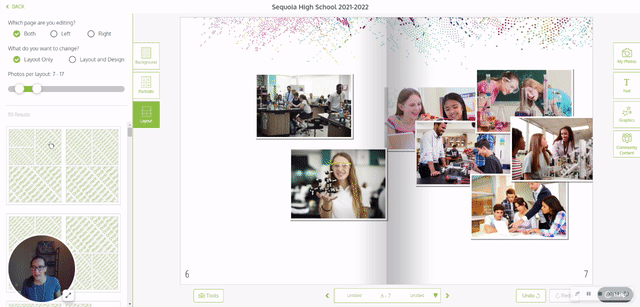
Step 6: Set Your Yearbook to Print Ready!
Drop the yearbook and walk away. In all seriousness, hit “print-ready” to send your files to the printers and, if you're using Treering, you'll quickly have your books in hand in three weeks or less! If for any reason you want a little more time, it’s easy to adjust print-ready deadlines too. As the yearbook coordinator, you're in charge!
Step 7: Distribute the Yearbook and Celebrate!
All this work is worth celebrating! Work with your parent group to host a yearbook signing party. It doesn't need to be fancy or cost you additional money; this could be something special like
- Playing music at lunch
- Offering a jeans day to yearbook buyers if you're a uniform school
- Allowing yearbook purchasers to bring a stuffed animal to school
- Setting up signing tables at a year-end school event
QR Code is a registered trademark of DENSO WAVE INCORPORATED.

How to get local media stoked about your yearbook
It’s common for school leaders to underestimate the newsworthy aspects of their school’s yearbook. They may think, “Our school is too small, so why would anyone outside of our students’ immediate families care about what’s going on with our yearbook?” Throughout a school year, consider all of the work that’s put toward building the book, the stories gathered, the candid photos captured, the skills gained, etc. Local media care about what’s going on in the community, and if they never know about it, there’s no opportunity for them to share with their greater audience. It’s time to consider getting local media completely stoked about your yearbook program!
1. Identify newsworthy aspects of your program
Oftentimes, yearbook-focused stories are going to resonate the most with smaller, hyperlocal outlets within a school’s community. This could include newspapers (print and online), TV, radio and even community newsletters. What you may think is a “meaningless story” could in fact impact readers in your hometown.
The following are high-level ideas to consider when thinking about working with local media:
- Position your yearbook adviser, or even the entire yearbook staff, as your school’s “hometown hero.” How are they positively impacting the school? What unique stories have they been able to capture for the yearbook that will pull at the heartstrings of the community?
- Reporters don’t want to talk to companies, they want to talk to people. Is the yearbook editor, parent coordinator, or even principal, media-prepped and comfortable speaking with reporters about the program?
- Local media tend to love stories with a multi-generational angle. How long has your yearbook program been in place? What unique, new aspects of the program can be shared? Do you have anyone on your yearbook team whose mother, grandmother, etc., was also involved in yearbook at the school years prior?
- Yearbook cover contests are a great opportunity to share a photo of the winning cover with media. Is this a contest that’s been occurring for years? Is it new? Are local artists involved? Reporters appreciate being given stats (i.e., years doing XYZ) as it helps strengthen a story.
- Share your successes. Has your yearbook earned recognition from your publisher?
2. Contact the right people
Depending on the size of the media outlet, some stations or publications have reporters that cover specific beats, while others that have a smaller staff have reporters that cover a wide variety of stories. If the outlet has a reporter that covers education, or more specifically K-12 education, this is someone to consider when your yearbook program has a story to share. Otherwise, reaching out to a general contact at an outlet, even if it’s for a general introduction if you’ve never worked with them before, is a great place to start.
It’s important to be professional, thorough, and to the point when reaching out to reporters and news outlets. Think about how yearbooks themselves convey stories through carefully selected phrases and high-res photos. Reporters are looking for the same: meaningful stories with images to support them.
3. Write a press release
Writing press releases is a common practice for businesses that want to announce a new product or feature, an award win, contest results, a new hire, etc. As it relates to a yearbook program, a press release would be most appropriate when announcing a yearbook contest award win, for example. Or if your school has never had a yearbook program and they have plans to launch one in the new year, this would be an opportunity to share a press release with local media.
So what should you include in the press release? Here’s an example to reference and a free press release template.
- Strong headline and subhead
- 3-5 body paragraphs (try to ensure that the press release is no longer than a page)
- A quote or two from leaders or subject matter experts to support the announcement
- Boilerplate at the bottom
- Contact person and their information (i.e. phone number, email address etc.)
Promote your yearbook program
In order for your yearbook program to flourish by increasing yearbook sales and growing your yearbook team, people need to know:
- What the yearbook program is all about and the importance of having a yearbook for students.
- How to get involved, and the specific steps to do so. Share the “how, what, why, and when” details if you really want your outreach efforts to make an impact. Consider creating a Facebook group for parents if you’re needing to recruit staff.
Treering's In the News page has plenty of examples of newsworthy yearbook programs.
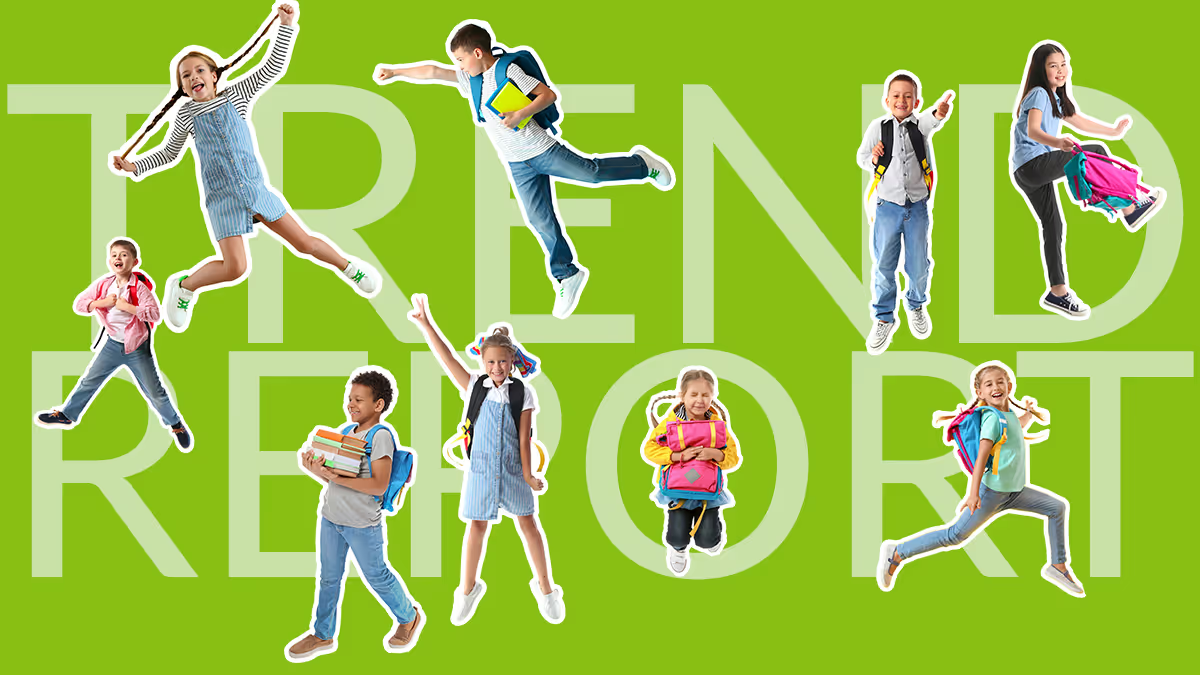
Year-end trend report
This is the time we often find ourselves reflecting on moments or trends that defined the year: countdowns dominate TV and radio, your Insta feed is filled with top nine collages, and influencers hype up-and-coming trends. Because the yearbook has the potential to be a campus influencer, below are just a couple of things to consider documenting in yours so students can look back and reminisce. It's easy to add trends and events that defined the year in the definitive archive of academia: your yearbook.
Current events
Add a trend timeline or spread so students can remember historic events, recall how most students chose to tuck in their t-shirts, or laugh at the social media craze during that time.
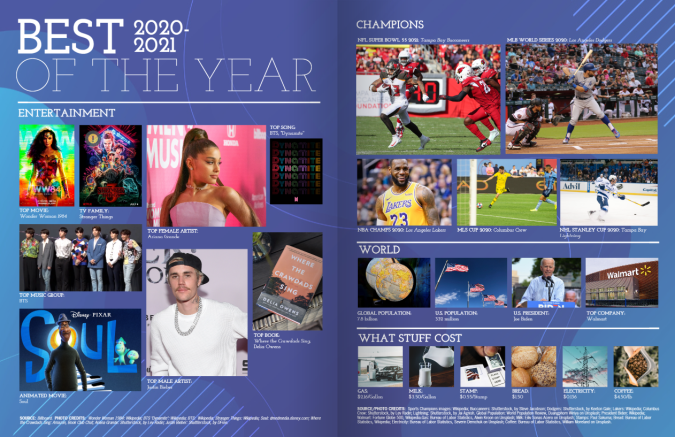
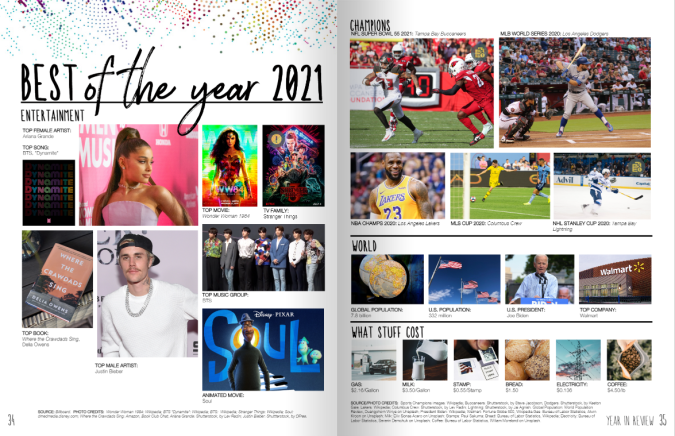
When it comes to including historic events to include in your school’s yearbook, it can be overwhelming about which ones to choose. When considering a year-defining moment, consider the impact it had on your local student body.
Natural disasters are also worth including in your year-end coverage. However, editors must do so while also keeping the sensitivity of the issue in mind. Did your school set up a donation drive to help victims of a tornado or hurricane that devastated another area of the country? Was your campus directly impacted?
Finding a local angle is a technique journalists often use when deciding how they plan to cover a specific event and it’s a tool yearbook editors can use as well. After all, you are a journalist who is documenting each school year!

Fashion trends
Historic moments aren’t the only element that defines a school year. Fashion is another key component that can help illustrate a certain time period as many students use this as an outlet to express themselves. To help determine the latest trends, a great first step is turning to Pinterest or Instagram. From there, have your yearbook staff find students who emulate some of those fads.
You could also assign an Outfit of the Day (#OOTD) photographer to capture students walking into school. Then, in your yearbook, you could feature seasonal styles. (Parents also love to submit these photos, so ask away!)


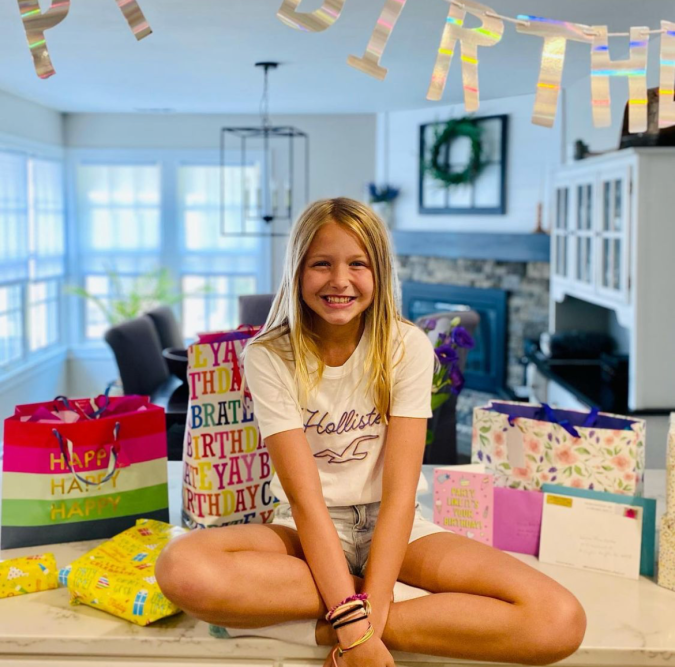
If you do a more traditional fashion spread, be sure to include:
- Mom jeans
- Chunky soled shoes, especially Dr. Martens
- White shoes
- Athletic gear
- Graphic Ts
- The return of the mullet
- Bucket hats (which we hear will be "out" come summer)
- Over-sized sweaters
- 90s style: neon, flannel, wide-legged pants
- Friendship bracelets
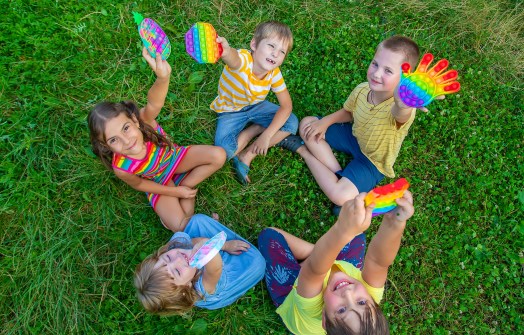
Social media trends
In addition to fashion, you can also consider incorporating social media trends that were popular over the past school year. Who knew TikTok would take off like it did? Remember when customizing your background and picking out songs for your MySpace page was all the rage? We do! Be sure to include some of the dances, trends, or popular songs students may be using on their own TikTok pages.
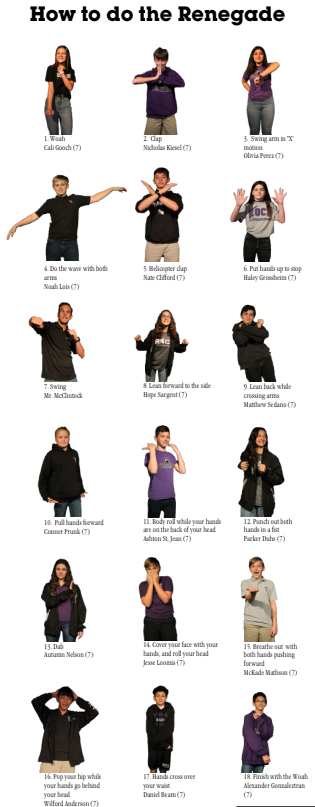
Students will love looking back at these memories 10 years from now, and their kids will love it even more!
